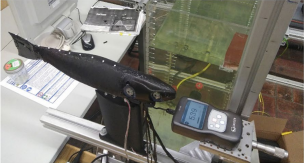Experimental replacement methods
An essential component of the project is the study of fish behavior during downstream migration under hydraulic conditions similar to those in turbine and pump intakes. The focus is on effects of acceleration of water flow and high flow velocities on fish. In addition, the modulating effect of light on behavioral patterns is investigated. Knowledge of fish behavior, and thus the characteristics of movement during turbine and pump passage, is considered essential for predicting damage risks. Ethohydraulics is the study of both ethology (behavior) and hydraulics with emphasis on the stimulus-response relationship for flow velocity, pressure, or their derivatives. The project aims to understand behavioral triggering in hydraulic systems in turbine and pump intakes. This will provide the base to predict fish behavior with numerical models. The focus on the inlet is a consequence of the assumption that fish reproducibly control their downstream location and velocity. Observations from laboratory studies indicate that accelerations such as those in the RETERO flume produce certain behavioral patterns in trout. To the authors' knowledge, there are few data on the behavior of live fish during turbine passage. In field studies, turbines are typically treated as "black boxes" because they are not visually or acoustically accessible, while laboratory studies are limited to smaller scale physical environments. Biologists typically compare the physiological state of fish before and after the passage, which provides a statistical estimate of damage. However, this provides only limited insight into the mechanisms leading to injury. The ethohydraulic experiments conducted as part of this project are only a first step in estimating the necessary behavioral rules. To identify response patterns, three hypotheses were formulated and three designs were installed. The first two hypotheses state that a longitudinal flow gradient or flow velocities in the range of the fish's maximum swimming speed will trigger the behavior in both daylight and darkness. For this purpose, the tapered geometry was chosen, which causes acceleration in the direction of flow. In the second, constantly wide part of the observation area, maximum velocities of up to 3 m/s are then achieved. Brook trout (Salmo trutta), some of which were equipped with biologgers, were inserted into the channel and the fish path was evaluated using 3D video tracking.![]()
The combination of tracking data and numerical simulations of flow variables enables the determination of thresholds for flow velocity and other triggering parameters. The tracking system uses IR light, which is not visible to trout. The third hypothesis deals with the response to transversal flow velocity gradients. For this purpose, a deflecting wall was used in the inlet area which generates a strong transversal gradient of up to 1 m/s/m in the front part of the observation area. First results show a significant behavioral change due to the spatial velocity gradient. Also, other behavioral rules like a clear preference of the bottom and the wall regions could be detected in the experiments.

Details of the Biologger experiments and field studies were presented at the 2022 Fish Passage Conference. The second instrument is a self-propelled sensor (Fig. left) that actively aligns itself in the current. These flexible fish robots with a soft tail guide a fish-like motion pattern of a subcarangiform swimmer, driven by piezoceramic actuators controlled by five control parameters. The sensors implemented in the robot are of similar technical capacity and design as the backpack sensors, which are integrated in the rigid head of the robot and communicate with its microcontroller over I²C. In the current state, navigation tests are conducted after optimizing the motion law of bio-inspired locomotion.





